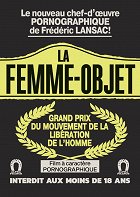Rendező:
Claude MulotForgatókönyvíró:
Claude MulotOperatőr:
François AboutZeneszerző:
Jean-Claude NachonRecenziók (1)
Mulot’s definitive farewell to pornography was, as expected, carried out in grand style. He was one of the few in the segment to give his films a creative signature not only in terms of formalistic trademarks and style, but also in terms of his view on sexuality. All of his previous directorial and screenwriting projects are characterised by exploring, problematising and even satirising gender norms in relation to sex and the duality of passivity and activity. Eloquently titled La Femme-Objet, the film represents the undiluted essence of this approach. The story of a writer who constructs a woman to satisfy his libido, but in the manner of Frankenstein’s monster, she becomes independent and, like the heroine of Shaw’s Pygmalion, takes control over her maker, subverts the very foundations of porn. The target of the film’s satire comprises the myths of the permanently virile and sexually avaricious man who always satisfies every woman and, conversely, the always ready and unhesitatingly accessible woman. The protagonist’s opening voiceover – “I'm a completely normal guy, except that I have a tremendous appetite for sex” – both foreshadows the absurdity of the image of the man in porn and signifies the macho conceit bound to the formula of the virile male. The protagonist’s active role is emphasised by his occupation as a writer, i.e. a creator and bearer of stories, as well as by his voiceover, which gives him the role of narrator of the film’s plot. His perpetual horniness requires a properly devoted counterpart, but no actual woman can fulfil his needs – his partner demands non-sexual attention and the hired secretary, a woman dehumanised by the burden of objectifying stereotypes and clichés, quits after a while. The porn-man’s perfect ideal thus becomes a woman-object, an artificial lover who responds to the impulses of a remote control, is always ready and has no personality or voice of her own. Through his voiceover, the protagonist even relates his creation to two of the greatest passivising mythologies of Western civilization – the Bible (he compares her to Eve) and cinema (he names her after his long-ago crush from the silver screen). But this porn-idyl, and with it the protagonist’s supposed self-confidence and power, doesn’t last long. The artificial woman becomes self-aware through her own pleasure and soon takes an active role in her relationship with her creator and with others. In the face of the female orgasm and desire, the macho myth collapses, and the protagonist is relegated to the role of a helpless observer and later becomes a responsive instrument of her pleasure. The continuing voiceover then shows the narrator to be the exact opposite of the active element – in the climax, his story becomes the confession of a passivised man and quite possibly also the verbalised fantasy of a man longing to be subjugated. In addition to elevating gender motifs to the central theme and dramatic arc, La femme-objet also represents the culmination of Mulot’s creative approach to pornography. Though it should be the ultimate porn flick in terms of quantity, most of its numerous sexual sequences are far from being raunchy. Instead, the sex depicted in the film serves solely as a narrative element and a means of presenting the characters. The same role is played by the set design and the formalistic treatment of those sequences. Most of the action takes place in a deliriously surreal luxury apartment, which Mulot constantly contrasts with the rubble strewn in the adjacent dirty street, thus emphasising the fantastical nature of pornography, or rather pornographic fantasies (porn was often filmed in houses or apartments that had been specially modified for swingers’ parties and orgies). A number of sequences make direct use of the various elements of the space as part of the narrative. One of the highlights in this respect is the sequence with a glass door, where the mise-en-scene, camerawork and editing jointly shape a brilliant formalistic satire on the objectifying male gaze. In the words of the director’s close friend and loyal collaborator, Didier Philippe-Gérard, Mulot always longed to work outside of the porn industry, which he fell back on at the beginning of his career only because it offered great creative freedom. Although he eventually made several non-pornographic films before his untimely death, he paradoxically never managed to surpass his career as a pornographer in terms of creativity, personal expression and creative ambition.
()
(kevesebbet)
(több)
